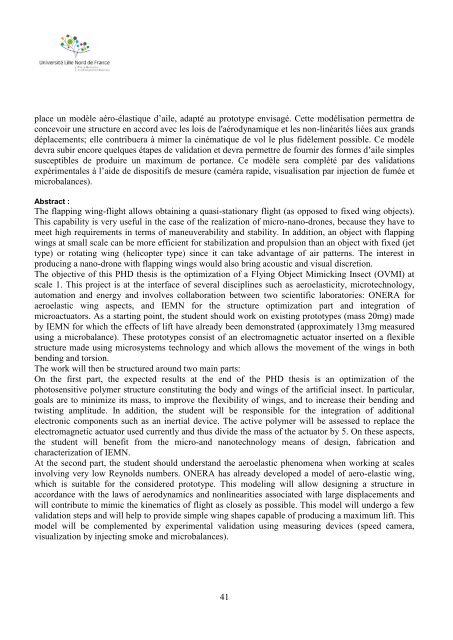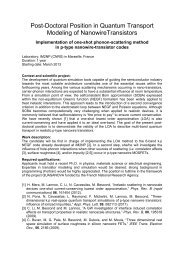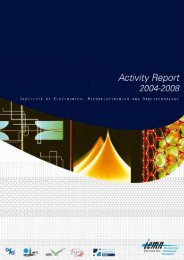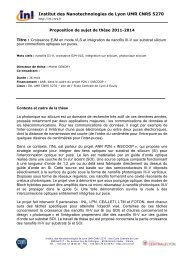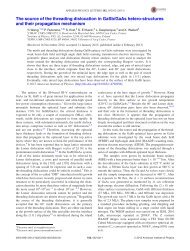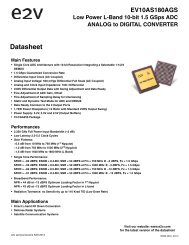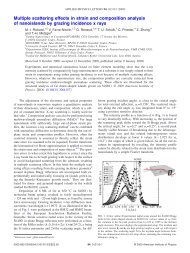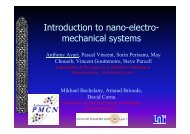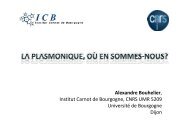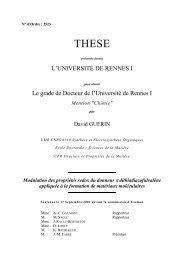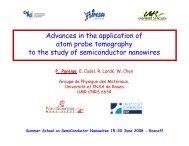Sujet de Doctorats 2013 - IEMN
Sujet de Doctorats 2013 - IEMN
Sujet de Doctorats 2013 - IEMN
- No tags were found...
Create successful ePaper yourself
Turn your PDF publications into a flip-book with our unique Google optimized e-Paper software.
place un modèle aéro-élastique d’aile, adapté au prototype envisagé. Cette modélisation permettra <strong>de</strong>concevoir une structure en accord avec les lois <strong>de</strong> l'aérodynamique et les non-linéarités liées aux grandsdéplacements; elle contribuera à mimer la cinématique <strong>de</strong> vol le plus fidèlement possible. Ce modèle<strong>de</strong>vra subir encore quelques étapes <strong>de</strong> validation et <strong>de</strong>vra permettre <strong>de</strong> fournir <strong>de</strong>s formes d’aile simplessusceptibles <strong>de</strong> produire un maximum <strong>de</strong> portance. Ce modèle sera complété par <strong>de</strong>s validationsexpérimentales à l’ai<strong>de</strong> <strong>de</strong> dispositifs <strong>de</strong> mesure (caméra rapi<strong>de</strong>, visualisation par injection <strong>de</strong> fumée etmicrobalances).Abstract :The flapping wing-flight allows obtaining a quasi-stationary flight (as opposed to fixed wing objects).This capability is very useful in the case of the realization of micro-nano-drones, because they have tomeet high requirements in terms of maneuverability and stability. In addition, an object with flappingwings at small scale can be more efficient for stabilization and propulsion than an object with fixed (jettype) or rotating wing (helicopter type) since it can take advantage of air patterns. The interest inproducing a nano-drone with flapping wings would also bring acoustic and visual discretion.The objective of this PHD thesis is the optimization of a Flying Object Mimicking Insect (OVMI) atscale 1. This project is at the interface of several disciplines such as aeroelasticity, microtechnology,automation and energy and involves collaboration between two scientific laboratories: ONERA foraeroelastic wing aspects, and <strong>IEMN</strong> for the structure optimization part and integration ofmicroactuators. As a starting point, the stu<strong>de</strong>nt should work on existing prototypes (mass 20mg) ma<strong>de</strong>by <strong>IEMN</strong> for which the effects of lift have already been <strong>de</strong>monstrated (approximately 13mg measuredusing a microbalance). These prototypes consist of an electromagnetic actuator inserted on a flexiblestructure ma<strong>de</strong> using microsystems technology and which allows the movement of the wings in bothbending and torsion.The work will then be structured around two main parts:On the first part, the expected results at the end of the PHD thesis is an optimization of thephotosensitive polymer structure constituting the body and wings of the artificial insect. In particular,goals are to minimize its mass, to improve the flexibility of wings, and to increase their bending andtwisting amplitu<strong>de</strong>. In addition, the stu<strong>de</strong>nt will be responsible for the integration of additionalelectronic components such as an inertial <strong>de</strong>vice. The active polymer will be assessed to replace theelectromagnetic actuator used currently and thus divi<strong>de</strong> the mass of the actuator by 5. On these aspects,the stu<strong>de</strong>nt will benefit from the micro-and nanotechnology means of <strong>de</strong>sign, fabrication andcharacterization of <strong>IEMN</strong>.At the second part, the stu<strong>de</strong>nt should un<strong>de</strong>rstand the aeroelastic phenomena when working at scalesinvolving very low Reynolds numbers. ONERA has already <strong>de</strong>veloped a mo<strong>de</strong>l of aero-elastic wing,which is suitable for the consi<strong>de</strong>red prototype. This mo<strong>de</strong>ling will allow <strong>de</strong>signing a structure inaccordance with the laws of aerodynamics and nonlinearities associated with large displacements andwill contribute to mimic the kinematics of flight as closely as possible. This mo<strong>de</strong>l will un<strong>de</strong>rgo a fewvalidation steps and will help to provi<strong>de</strong> simple wing shapes capable of producing a maximum lift. Thismo<strong>de</strong>l will be complemented by experimental validation using measuring <strong>de</strong>vices (speed camera,visualization by injecting smoke and microbalances).41


